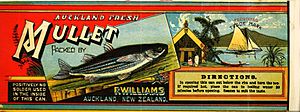Yellow-eye mullet facts for kids
Quick facts for kids Yellow-eye mullet |
|
|---|---|
 |
|
| Conservation status | |
| Scientific classification | |
| Synonyms | |
|
Aldrichetta forsteri nonpilcharda Whitley, 1951 |
The yellow-eye mullet is a small fish often found near coastlines. It's known for its bright yellow eyes and silvery body. Even though it tastes good, it's mostly used as bait for catching bigger fish. This fish is really popular with anglers because many larger sea creatures love to eat it!
Contents
About the Yellow-Eye Mullet
Yellow-eye mullet are small fish that live close to shore. They usually grow to be about 30 to 40 centimeters long. Their bodies are gray-green on top and silver underneath. They have bright yellow eyes, which is how they get their name!
Even though they taste good, these fish are often used as bait. Many people think they are the best bait for catching larger fish. Fresh mullet fillets, with their natural juices, are very tempting to almost any fish in the ocean.
These fish have pointed heads and mouths. Their scales are very small and thin, and they fall off easily. Unlike most fish, the yellow-eye mullet has two special fins on its back. The first one has four sharp spines, and the second has one spine and nine soft rays.
Yellow-eye mullet can be olive or blue-brown in color. Their sides are silver, and their eyes are a bright yellow or gold. The edges of their fins are brown. These fish can live in water from 0 to 50 meters deep. However, they usually stay in shallower water, from 0 to 10 meters deep. They like water temperatures between 14 and 24 degrees Celsius. They can handle temperatures up to 28 degrees Celsius, but we don't know their lowest temperature limit.
Where Yellow-Eye Mullet Live
Global Homes of the Mullet
You can find yellow-eye mullet in the Southwest Pacific Ocean. They live off the coasts of Western Australia, Southern Australia, and Tasmania.
Mullet in New Zealand
These fish are also found all over New Zealand. They even live around the Chatham Islands, which are far to the east of New Zealand.
Life Cycle and Growth
Yellow-eye mullet can live for up to seven years. They lay their eggs between December and March. Some people think they might also lay eggs in winter. They usually lay their eggs in coastal waters or in river mouths during summer and autumn.
A single female fish can release up to 680,000 eggs! Mullet usually become adults and can have babies when they are 2 to 4 years old. Female mullet tend to grow faster and get bigger than male mullet.
What Yellow-Eye Mullet Eat
Yellow-eye mullet are omnivores, which means they eat both plants and animals. They feed on things found on the sea floor, like bits of plants, algae, and small invertebrates. Invertebrates are tiny creatures without backbones, like worms or small crabs.
They eat a wide variety of foods. This includes different types of algae, small crustaceans, diatoms (tiny plant-like organisms), mollusks (like snails), insect larvae, and even fish eggs. They often filter food from the sand using their mouths. Eating a little bit of sand actually helps them grind up their food in their stomach muscles!
Who Eats Yellow-Eye Mullet
In the ocean's food chain, yellow-eye mullet are prey for bigger animals. Large predators like dolphins and killer whales hunt them. Since these mullet are often used as bait fish, many big meat-eating marine animals will try to catch and eat them.
How People Use Yellow-Eye Mullet
People catch yellow-eye mullet in two main ways for business. One way is through a marine beach fishery. Here, the goal is to catch adult fish when they are full of eggs. Their eggs, called caviar, are very valuable. There is a high demand for this caviar in Australia and other countries. The fish itself can be sold fresh, smoked, or dried. Fishermen use special beach nets to catch them this way.
The second main way to catch them is through estuary fisheries. Estuaries are where rivers meet the sea. Most of the mullet caught come from these areas. Yellow-eye mullet are caught all year round. However, most of them are caught in late summer and autumn. Fishermen use gill nets, which are like walls of netting, and tunnel nets to catch them.
When choosing fresh mullet, people look for shiny skin, firm meat, and a fresh ocean smell. If you are buying fillets, look for pink or gray meat that is firm, shiny, and moist. It should not have any brown marks or be watery. It should also have a pleasant, fresh ocean smell.
See also
 In Spanish: Aldrichetta forsteri para niños
In Spanish: Aldrichetta forsteri para niños



